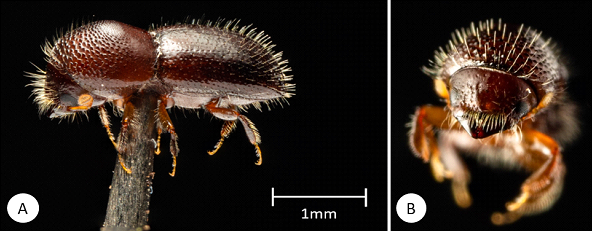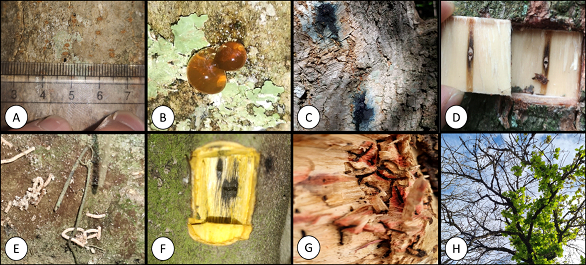The polyphagous shot hole borer (PSHB), Euwallacea fornicatus, is a tiny, invasive ambrosia beetle native to Southeast Asia. Ambrosia beetles are a group of tiny woodboring insects, closely related to weevils, that create gallery systems in the wood they infest. In its native range in Southeast Asia, PSHB beetles inhabit tropical forests where they infest dead or dying trees, but in its invaded areas it attacks living and seemingly healthy trees. PSHB was first discovered in South Africa in 2017 in Pietermaritzburg and has since been found in eight of the nine provinces. It is also invasive in Israel, the USA and as of 2021, in Australia.

Figure 1. (A) An adult female PSHB beetle, measuring between 1.8 to 2.6mm long and (B) A frontal view of a female PSHB beetle, showing the mycangia (fungal pocket) just above the mouthparts.
How do they attack trees?
Female beetles will bore into a tree using her mouthparts and a small saw-like structure on the top of her head, she will then plant a fungus carried in a small pocket (a mycangium) above her mouthparts. This symbiotic fungus, called Fusarium euwallaceae, will begin to grow in the galleries in the sapwood of the tree. Once the fungus starts growing, she will feed on it before starting to deposit her eggs. Once she starts breeding within a tree, the galleries will grow and the fungal infection will spread, blocking the vessels of the tree and causing a disease known as Fusarium dieback. Soon there could be up to 40 female beetles in a single gallery. They will eventually leave to start their own colony, either boring into the same tree or finding a new one. Female beetles can fly up to 2km unassisted by wind, while males are wingless and cannot follow a female to a new tree. To overcome this, females colonizing a new host create their own males. Female PSHB beetles are haplodiploid, meaning they can lay unfertilized eggs that hatch into males, which they will then mate with to produce fertilized eggs that hatch into female beetles. This is one of many traits that make these beetles such good invaders. Below is a figure showing some of the symptoms of PSHB attack on trees, but it should be noted that these symptoms are different for different tree species. A more comprehensive list of symptoms can be found at www.fabinet.up.ac.za/index.php/research-groups/pshb-new/brochures.
PSHB beetles do not attack all tree species and not all of those they do attack will die. The beetles also cannot breed in all the tree species they attack. Tree species they can breed in are known as “reproductive hosts” and exhibit more severe Fusarium dieback symptoms and are much more likely to die. However, even if the beetle is not reproducing in a tree, “non-reproductive” hosts can still die from the fungal infection if it spreads over time.
It is difficult to predict which trees will be attacked by PSHB and the host list continues to grow. Non-native tree species such as English oaks, London planes, maples and some willow species are all at risk of attack and are important reproductive hosts of PSHB. Native species like coral trees are also attacked. Although many tree species are susceptible to PSHB attack, some species do appear to be able to defend themselves from the fungal infection. An updated list of confirmed hosts in South Africa can be found at www.fabinet.up.ac.za/pshb/.

Figure 2. The first symptom of PSHB attack to look out for is (A) a beetle entry hole measuring 1.1mm in diameter. Some trees will exude sap from entry holes (B), which can also cause dark staining on the bark of a tree (C). If the outer layer of bark is removed from around a PSHB entry hole often there will be fungal staining present as the fungus grows in the sap wood of the tree (D). Compacted sawdust called ‘frass noodles’ are often pushed out of the entry holes as the beetles create their tunnels (E). If the beetles begin reproducing inside a host tree lateral (sideways) tunnels will be present (F and G) but can be difficult to spot unless you remove a large piece of wood or a branch. Once the fungal infection in a tree spreads it can cause dieback of branches on the host tree (H) which can eventually lead to death.
Current research on PSHB
The PSHB Research Network, made up of researchers from various institutions and universities, are constantly sharing information, data and new ideas so we can better understand and control this pest. Currently, projects range from surveys in indigenous forests and tree orchards to assess the severity and spread of the beetle and assess which tree species are most at risk, and investigating the potential for the management of the beetle and/or its fungus through biological control or other measures. A full list of PSHB projects can be found at www.fabinet.up.ac.za/index.php/research-groups/pshb-research-network/projects.
What can we do?
The movement of infested wood is an important pathway for the spread of PSHB and so must be disposed of correctly by either chipping/composting, solarization or burning. This will be key to reducing the spread of this beetle. The public can also assist by looking out for symptoms on trees. Suspected instances can be reported to [email protected].
Infested trees can be treated with systemic chemicals but, on a large scale, this is not feasible. In addition, very few of these chemicals have been meticulously tested and their success in controlling the beetle / fungus as well as impact on the surrounding environment are largely unknown. The potential of parasitoids, pathogens or antagonistic fungi as potential biocontrol agents of PSHB is also being investigated.
By Garyn Townsend
